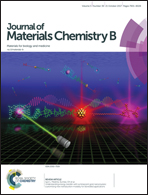Biodegradable and biocompatible monodispersed hollow mesoporous organosilica with large pores for delivering biomacromolecules†
Abstract
The construction of large pore-sized hollow mesoporous organosilica nanoparticles (HMONs) with a concurrent small particle size is of great challenge for the delivery of large biomacromolecules. In this work, we report, for the first time, on the construction of monodispersed and biodegradable HMONs with a unique large mesopore size, hollow interior, a small particle size and a molecularly organic–inorganic hybrid framework. The incorporation of thioether groups into the framework of large pore-sized HMONs (LHMONs) leads to the fast biodegradation of the nanocarriers with specific responsibility and acceleration to the reducing microenvironment. Systematic in vivo biocompatibility assays of LHMONs demonstrate their high biosafety for potential clinical translation. Based on their large mesopore and high pore volume, these LHMONs show high drug-loading capacity for large biomolecular proteins (RNase A), efficient intracellular uptake and a high therapeutic outcome against cancer cells as compared to free protein drugs because of their unique structural features. This first demonstration of the construction of molecularly organic–inorganic hybrid HMONs with a unique large mesopore size, a small particle size and tumor microenvironment-responsive biodegradability promises the intracellular delivery of biomacromolecules for various therapeutic applications, especially for combating cancer.



 Please wait while we load your content...
Please wait while we load your content...